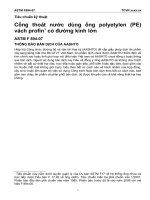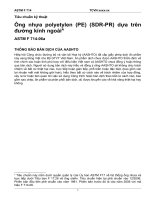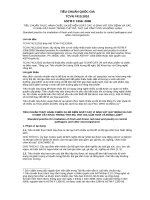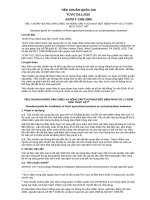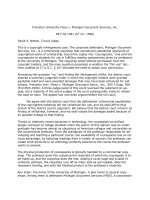Astm f 459 13
Bạn đang xem bản rút gọn của tài liệu. Xem và tải ngay bản đầy đủ của tài liệu tại đây (94.69 KB, 5 trang )
Designation: F459 − 13
Standard Test Methods for
Measuring Pull Strength of Microelectronic Wire Bonds1
This standard is issued under the fixed designation F459; the number immediately following the designation indicates the year of original
adoption or, in the case of revision, the year of last revision. A number in parentheses indicates the year of last reapproval. A superscript
epsilon (´) indicates an editorial change since the last revision or reapproval.
This standard has been approved for use by agencies of the U.S. Department of Defense.
2. Referenced Documents
1. Scope
2.1 ASTM Standards:3
F458 Practice for Nondestructive Pull Testing of Wire Bonds
1.1 These test methods cover tests to determine the pull
strength of a series of wire bonds. Instructions are provided to
modify the methods for use as a referee method. The methods
can be used for wire bonds made with wire having a diameter
of from 0.0007 to 0.003 in. (18 to 76 µm).
3. Terminology
3.1 Definitions of Terms Specific to This Standard:
3.1.1 For the purposes of these test methods the following
failure points are defined:
3.1.2 bond-wire junction failure—a rupture in the wire
within two wire diameters of the bond and in which more than
25 % of the bonded area is left on the pad after the pull test has
been applied.
3.1.3 weld interface failure—a rupture in which less than
25 % of the bonded area is left on the pad after the pull test has
been applied. See pad lifting in 6.6.
3.1.4 wire span failure—a rupture in the wire other than (1)
at a point within two wire diameters of either bond, or (2) at the
point at which the hook contacted the wire.
NOTE 1—Common usage at the present time considers the term “wire
bond” to include the entire interconnection: both welds and the intervening wire span.
1.2 These test methods can be used only when the loop
height of the wire bond is large enough to allow a suitable hook
for pulling (see Fig. 1) to be placed under the wire.
1.3 The precision of these methods has been evaluated for
aluminum ultra-sonic wedge bonds; however, these methods
can be used for gold and copper wedge or ball bonds.2
1.4 These methods are destructive. They are appropriate for
use in process development or, with a proper sampling plan, for
process control or quality assurance.
4. Summary of Test Methods
1.5 A nondestructive procedure is described in Practice
F458.
4.1 The microelectronic device with the wire bond to be
tested is held firmly in an appropriate fixture. A hook is
positioned under the wire midway between the two bonds. The
hook is then raised until the wire bond breaks. The force
applied to the hook in order to cause failure of the wire bond
is recorded. The point of failure is observed and recorded. In
the referee method, the force in the wire on breaking is
calculated.
1.6 The values in SI units are to be regarded as standard.
1.7 This standard does not purport to address all of the
safety concerns, if any, associated with its use. It is the
responsibility of the user of this standard to establish appropriate safety and health practices and determine the applicability of regulatory limitations prior to use.
5. Significance and Use
1
These test methods are under the jurisdiction of ASTM Committee F01 on
Electronics and are the direct responsibility of Subcommittee F01.03 on Metallic
Materials, Wire Bonding, and Flip Chip.
Current edition approved Jan. 1, 2013. Published January 2013. Originally
approved in 1976 as F459 – 76 T. Last previous edition approved in 2006 as
F459 – 06. DOI: 10.1520/F0459-13.
2
Harman, G. G., ”Microelectronic Ultrasonic Bonding,” NBS Special Publication 400-2, pp. 94-95 and “Wire Bonding in Microelectronics,” Third Edition,
McGraw Hill, 2010. Also Microelectronics Reliability 51 (2011), Special Issue on
Copper bonding.
5.1 Failure of microelectronic devices is often due to failure
of an interconnection bond. A common type of interconnection
bond is a wire bond. These methods can assist in maintaining
3
For referenced ASTM standards, visit the ASTM website, www.astm.org, or
contact ASTM Customer Service at For Annual Book of ASTM
Standards volume information, refer to the standard’s Document Summary page on
the ASTM website.
Copyright © ASTM International, 100 Barr Harbor Drive, PO Box C700, West Conshohocken, PA 19428-2959. United States
1
F459 − 13
FIG. 1 Suggested Configuration for a Pulling Hook
sharp edges in any part of the hook that contacts the wire loop.
The hook should be rigidly mounted in the pulling apparatus.
7.1.2 Lifting-and-Gaging Mechanism —Mechanism for applying a measured vertical force to the hook. The mechanism
shall incorporate a means for recording the maximum force
applied and shall be capable of applying force at a rate constant
to within 2 gf/s (20 mN/s) in the range from 1 to 30 gf/s (10 to
290 mN/s) inclusive. A mechanism with a single fixed scale
shall have a maximum scale reading no greater than three times
the nominal bond pull strength anticipated.
control of the process of making wire bonds. They can be used
to distinguish between weak, nonadherent wire bonds and
acceptably strong wire bonds. The methods are destructive.
5.2 These test methods are appropriate for on-line use for
process control, for purchase specifications, and for research in
support of improved yield or reliability. The referee method
should be used for quantitative comparison of pull strengths of
wire bonds.
6. Interferences
6.1 Failure to center the hook along the loop between the
two bonds or pulling in a direction not lying in the plane
containing the undisturbed loop may invalidate the test since an
unbalanced distribution of forces between the two bonds may
result.
NOTE 2—Mechanisms of the dynamometer type known as “gram
gages” have been found satisfactory, but currently, electronic gauges
(properly calibrated using the manufacturers’ procedures) are more
common.
7.1.3 Microscope with Light Source —Zoom microscope
with light source with a magnification range of approximately
14× to 60× with the eyepiece not to exceed 10×, for viewing
the device under test.
7.1.4 Device Holder— Mechanism for holding the device
under test (1) in a horizontal position, for Method A, or (2) in
either a horizontal or a tipped position so that both bonds are
in the same horizontal plane, for Method B. For the referee
Method C, the device holder should provide a measurement, to
within 2°, of the angle from the horizontal (which may be zero)
through which the device has been tipped.
7.1.5 Calibration Masses—At least five masses (weights)
with mass values known to within 0.5 % sized to cover the
lifting-and-gaging mechanism range of force measurement,
and suitably configured so that they may be supported by the
pulling mechanism for calibration.
6.2 Slippage of the hook along the wire span during pulling
may invalidate the test because an unbalanced distribution of
forces between the two bonds may result.
6.3 Careless insertion of the hook may damage either bond
or wire and thus invalidate the test.
6.4 The presence of vibration or mechanical shock may
cause the application of an extraneous force and thus invalidate
the test.
6.5 Measured bond-pull force is strongly dependent on the
height of the loop (H + h, as defined in 11.1.1) and the
bond-to-bond spacing ( d, as defined in 11.1.1).
6.6 For fine pitch ball bonds (<60 µm pitch), the bond pad
may tear and lift during pull testing. Current practice is to
accept this if the pull force is acceptably high under agreed
upon requirements, but note it as appropriate. In some cases of
bad peeling, it is necessary to move the pulling hook directly
over the top of the ball bond. This should be noted.
8. Sampling
8.1 Since the pull-test method is destructive, it shall be
performed on a sampling basis. The sample selected should be
representative of the wire bonds of interest. The size of the
sample and the method of selection shall be agreed upon by the
parties to the test.
7. Apparatus
7.1 Bond-Pulling Machine—Apparatus for measuring wirebond pull strength with the following components:
7.1.1 Hook—Pulling hook made from a rigid wire such as
tungsten. The diameter of that part of the hook that contacts the
wire loop should be approximately 2.5 times the diameter of
the wire used to make the wire bond. A suggested hook
configuration is shown in Fig. 1. The hook should appear under
visual inspection to have a smooth polished surface with no
9. Calibration
9.1 Calibrate the bond-pulling machine at the beginning of
each series of tests, or daily if a series spans more than one day.
9.2 Assemble the bond-pulling machine in the same configuration to be used to perform the wire-bond pull test.
2
F459 − 13
9.3 Calibrate the lifting-and-gaging mechanism.
9.3.1 For mechanisms incorporating a calibration
adjustment, either calibrate the mechanism in accordance with
the manufacturer’s instructions or in accordance with the
procedure of 9.3.2.
9.3.2 For mechanisms without a calibration adjustment, use
the following procedure:
9.3.2.1 Select masses that will provide at least five calibration points over the mechanism range.
9.3.2.2 Attach a selected calibration mass to the lifting-andgaging mechanism. If a lever-arm mechanism (dynamometer
or gram gage) is used, rotate the body of the gage in a manner
that maintains the arm (carrying the hook) in a horizontal
orientation.
9.3.2.3 Observe and record the measured force in gramsforce (millinewtons).
9.3.2.4 Repeat 9.3.2.2 and 9.3.2.3 for each calibration mass
(or electronic scale) selected.
9.3.2.5 Plot the measured force values as a function of the
forces applied by the masses. Use these results to construct a
calibration curve.
10.1.7 Measure and record the force required for breaking
the wire bond. Determine and record the corrected force from
the calibration curve if the calibration procedure of 9.3.2 was
used. Record the identification of the wire bond and the
identification of the device (substrate).
10.1.8 Examine the remaining parts of the bonds and the
wire span at appropriate magnification to determine the nature
and location of the failure.
10.1.9 Record the failure location as being one of the
following:
10.1.9.1 First bond at the weld interface,
10.1.9.2 First bond at the bond-wire junction,
10.1.9.3 In the wire span,
10.1.9.4 Second bond at the weld interface,
10.1.9.5 Second bond at the bond-wire junction, or
10.1.9.6 Other (describe: for example, pad lift-off (see 6.6)).
10. Procedures
10.2 Method B—Device in Tipped Plane:
10.2.1 Place the device having the wire bond to be tested in
a device holder capable of tipping.
10.2.2 Perform steps 10.1.2 and 10.1.3.
10.2.3 Tip the holder (if required) until both bonds appear to
be in sharp focus as viewed through the microscope.
NOTE 3—The operator will normally be supplied information as to
which is the first bond and which is the second bond.
NOTE 4—If the tester is electronic with optical placement control, then
all hook placement/positioning is set up during the initial machine
calibration. However, failure mode determination will be evaluated by the
operator.
10.1 Method A—Device in Horizontal Plane:
10.1.1 Place the device having the wire bond to be tested in
the device holder so that the plane of the device is horizontal,
as judged visually.
10.1.2 Position the microscope and light source and focus
the microscope so that the wire bond to be tested is clearly seen
in the microscope field.
10.1.3 Position the device holder so that the wire forming
the loop of the wire bond to be tested is under the rigidly
mounted pulling hook.
10.1.4 While viewing the wire bond through the
microscope, maneuver the hook so that it is under the wire loop
to be pulled, and adjust the hook so that it is midway between
the two bonds and contacting the wire loop, as judged by eye.
10.1.5 Activate the pulling mechanism while observing the
wire bond and hook through the microscope. Continue pulling
until there is failure.
10.1.6 If the wire fails at the point of contact with the hook,
record the test for that bond as invalid.
NOTE 5—Care should be taken not to tip the wire bond about the
bond-line axis. However, a judgment by eye through the microscope is
adequate, as an error of a few degrees will not significantly alter the
measured pull strength. This tipped-plane method is not considered
applicable to an optical-electronic or other automatic pull tester.
10.2.4 Perform steps 10.1.4 – 10.1.9.
10.3 Method C—Referee Method (To be done with a manual
pull tester and full operator participation):
10.3.1 Measure and record the horizontal distance (d) between the two bonds, the vertical distance (H) between the two
bonds, and the loop height (h) as shown in Fig. 2. Use the same
unit of measurement for d, h, and H.
10.3.2 Use either Method A or Method B, whichever is
appropriate.
FIG. 2 Diagram of a Typical Wire Bond
3
F459 − 13
12.1.2 Date of the test,
12.1.3 Identification of the wire-bond pull tester,
12.1.4 Identification of the device,
12.1.5 Identification of each wire bond,
12.1.6 Corrected force in grams-force (or millinewtons)
required to break the wire bond, and
12.1.7 Location of failure.
10.3.3 If Method B is used, read and record the tip angle
(the angle through which the device has been tipped from the
horizontal) to within 2°.
11. Calculation (for Method C)
11.1 If the substrate was tipped from the horizontal, calculate the force in grams-force (or millinewtons) in the wire at
failure.
11.1.1 If failure occurs at the higher of the two bond sites,
calculate the force in the wire as follows:2
ΠS DF
S D
d
2h
H
11
2h
11
F hi 5 F
2
1
cosφ1
2
S
12.2 Method B—In addition to that required by 12.1, the
report for Method B shall contain the angle through which the
device was tipped.
12.3 Method C—In addition to that required by 12.1, the
report for Method C shall contain the following:
12.3.1 Measured values of d, H, and h, in the same units,
12.3.2 Angle through which device was tipped, if Method B
was used, and
12.3.3 Calculated force in the wire in grams-force (or
millinewtons).
D G
h1H
sinφ
d
where:
F hi = force in the wire on the high side, gf (or mN),
F
= corrected applied pull force, gf (or mN),
d
= horizontal distance between the two bonds along a
parallel to plane of device,
H
= vertical distance between the two bond sites along a
perpendicular to plane of device,
h
= loop height as defined in Fig. 2, and
φ
= angle through which device has been tipped.
13. Precision and Bias
13.1 An interlaboratory evaluation of these test methods
was carried out as follows:
13.1.1 Six laboratories participated, including the originating laboratory.
13.1.2 Aluminum ultrasonic wedge bonds were used employing Al-1 % Si wire 0.001-in. (25.4-µm) diameter.
13.1.3 Each test specimen prepared by the originating
laboratory contained groups of bonds with three different mean
pull strengths: high-quality bonds, approximately 10 gf (98
mN); average-quality bonds, approximately 7.5 gf (74 mN);
and low-quality (overly deformed) bonds, approximately 4.0 gf
(39 mN).
11.1.2 If failure occurs at the lower bond site, calculate the
force in the wire as follows:
S DΠF
S D
H
h
F lo 5
H
11
2h
11
11
d
2 ~ H1h !
GF
2
1
h
cosφ 2 sinφ
2
d
G
where Flo = force in the wire at the low side in grams-force
(or millinewtons) and the other symbols are as indicated in
11.1.1.
13.2 The wire-bond pull test is destructive, and different test
samples do not necessarily represent bonds from the same
statistical population. Therefore, the results from test samples
in the interlaboratory round robin are compared after normalizing the values with results from the originating laboratory.
13.2.1 The selected estimate of precision for each group is
given by the relation:
11.2 If the device was not tipped from the horizontal,
calculate Fhi and Flo as follows:
ΠS D
d
2h
H
21
h
11
F hi 5 F
S D
S DΠF
S D
H
h
H
21
h
11
F lo 5 F
2
11
d
2 ~ H1h !
Estimate of precision, % 5
G
200 S x¯
G
where:
Sx¯ = sample standard deviation of the normalized mean
values obtained by each cooperating laboratory for the
given group, and
G = nominal group pull strength given in 13.1.3.
2
where the symbols have the same meaning as in 11.1.1 and
11.1.2.
13.2.2 The group precision values are for wire bonds of high
quality, 8.0 %; average quality, 10.4 %; and low quality,
27.2 %.
12. Report
12.1 Method A—The report for Method A shall contain the
following:
12.1.1 Name of the person performing the test,
14. Keywords
14.1 microelectronic wire bonds; pull strength; wire bonds
4
F459 − 13
ASTM International takes no position respecting the validity of any patent rights asserted in connection with any item mentioned
in this standard. Users of this standard are expressly advised that determination of the validity of any such patent rights, and the risk
of infringement of such rights, are entirely their own responsibility.
This standard is subject to revision at any time by the responsible technical committee and must be reviewed every five years and
if not revised, either reapproved or withdrawn. Your comments are invited either for revision of this standard or for additional standards
and should be addressed to ASTM International Headquarters. Your comments will receive careful consideration at a meeting of the
responsible technical committee, which you may attend. If you feel that your comments have not received a fair hearing you should
make your views known to the ASTM Committee on Standards, at the address shown below.
This standard is copyrighted by ASTM International, 100 Barr Harbor Drive, PO Box C700, West Conshohocken, PA 19428-2959,
United States. Individual reprints (single or multiple copies) of this standard may be obtained by contacting ASTM at the above
address or at 610-832-9585 (phone), 610-832-9555 (fax), or (e-mail); or through the ASTM website
(www.astm.org). Permission rights to photocopy the standard may also be secured from the Copyright Clearance Center, 222
Rosewood Drive, Danvers, MA 01923, Tel: (978) 646-2600; />
5
